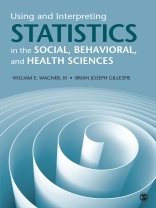Using and Interpreting Statistics in the Social, Behavioral, and Health Sciences is designed to be paired with any undergraduate introduction to research methods text used by students in a variety of disciplines. It introduces students to statistics at the conceptual level—examining the meaning of statistics, and why researchers use a particular statistical technique, rather than computational skills. Focusing on descriptive statistics, and some more advanced topics such as tests of significance, measures of association, and regression analysis, this brief, inexpensive text is the perfect companion to help students who have not yet taken an introductory statistics course or are confused by the statistics used in the articles they are reading.
Innehållsförteckning
Acknowledgments
Chapter 1: Brief Introduction to Research in the Social, Behavioral, and Health Sciences
What Is the Purpose of Research?
How Is Research Done?
Scientific Method and Hypothesis Testing
Inductive Research
Deductive Research
Research Designs
Chapter 2: Variables and Measurement
Variables and Data
Levels of Variable Measurement
Types of Relationships
Research Design and Measurement Quality
Chapter 3: How to Sample and Collect Data for Analysis
Why Use a Sample?
Probability Sampling Methods
Nonprobability Sampling Methods
Validating a Sample
Split Ballot Designs
How and Where Are Data Collected Today?
Chapter 4: Data Frequencies and Distributions
Univariate Frequencies and Relative Frequencies
Cumulative Percentages and Percentiles
Frequencies for Quantitative Data
Univariate Distributions
The Normal Distribution
Non-Normal Distribution Characteristics
Data Transformations for Dealing With Non-Normal Distributions
Bivariate Frequencies
Chapter 5: Using and Interpreting Univariate and Bivariate Visualizations
Univariate Data Visualization
Bivariate Data Visualization
Chapter 6: Central Tendency and Variability
Understanding How to Calculate and Interpret Measures of Central Tendency
Understanding How Individuals in a Distribution Vary Around a Central Tendency
Chapter 7: What Are z Scores, and Why Are They Important?
What Is a z Score?
How to Calculate a z Score
The Standard Normal Table
Working With the Standard Normal Distribution to Calculate z Scores, Raw Scores, and Percentiles
Confidence Intervals
Chapter 8: Hypothesis Testing and Statistical Significance
Null and Alternative Hypotheses
Statistical Significance
Test Statistic Distributions
Choosing a Test of Statistical Significance
The Chi-Square Test of Independence
The Independent Samples t Test
One-Way Analysis of Variance
Chapter 9: How to Measure the Relationship Between Nominal and Ordinal Variables
Choosing the Correct Measure of Association
Trying to Reduce Error (PRE Statistics)
Calculating and Interpreting Lambda
Calculating and Interpreting Gamma
Calculating and Interpreting Somers’ d
Calculating and Interpreting Kendall’s Tau-b
Interpreting PRE Statistics Overview
Chapter 10: Effect Size
Effect Size
Choosing an Effect Size
Chapter 11: How to Interpret and Report Regression Results
What Is a Regression?
Correlation
Bivariate Regression
Coefficient of Determination (r2)
Multiple Regression
Logistic Regression
Chapter 12: Indices, Typologies, and Scales
Indices, Typologies, and Scales Defined and Explained
Appendix A. The Standard Normal Table
Appendix B. Critical Values for t Statistic
Appendix C. Critical Values for Chi-Square
Appendix D. Critical Values for F Statistic
Appendix E. Glossary
About the Authors
Om författaren
Brian Joseph Gillespie, Ph.D. is a researcher in the Faculty of Spatial Sciences at the University of Groningen in the Netherlands. He is the author of Household Mobility in America: Patterns, Processes, and Outcomes (Palgrave, 2017) and coauthor of The Practice of Survey Research: Theory and Applications (Sage, 2016) and Using and Interpreting Statistics in the Social, Behavioral, and Health Sciences (Sage, 2018). He has also published research in a variety of social science journals on topics related to family, migration, the life course, and interpersonal relationships.












